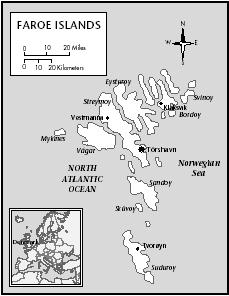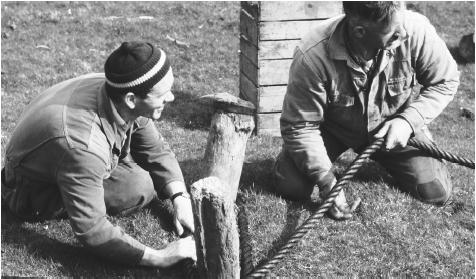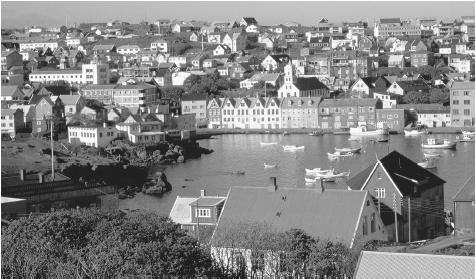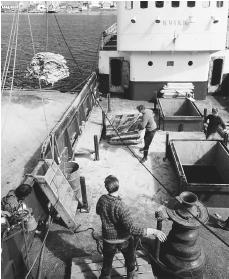Faroe Islands
Culture Name
Faroese
Alternative Names
Føroyar; Fóðrøerne
Orientation
Identification. "Faroe" (sometimes "Faeroe") may mean "Sheep Islands." The population is monoethnic, but is culturally distinct within Denmark as a whole. Within Norse Scandinavia, Faroese consider themselves most like Icelanders and least like Swedes.
Location and Geography. The Faroes include seventeen inhabited islands and numerous islets. The area is 540 square miles (1,397 square kilometers). The weather is cool and damp, with frequent winter storms. The landscape is treeless and mountainous, deeply cut with fjords and sounds along whose shores nucleated villages lie surrounded by fields and pastures. The capital has been Tórshavn since Viking times.
Demography. The total population in 1997 was 44,262, up about threefold since 1901(15,230) and about eightfold since 1801 (5,265). Tórshavn, with 14,286 inhabitants, is the only city. Klaksvík has 4,502 inhabitants, and seven other towns have over a thousand. The rest of the population (33.2 percent) lives in smaller places.
Linguistic Affiliation. Faroese is a syntactically conservative west Scandinavian language most closely related to Icelandic and the western dialects of Norwegian, from which it apparently began to diverge significantly after the Reformation while resisting assimilation to Danish. Reduced to writing in 1846 and redeployed for modern use since the late nineteenth century, it is a primary symbol of national identity, spoken and written by all Faroese. Faroese are fluent in Danish and increasingly in English.
Symbolism. Faroese consider themselves "ordinary people" living in "a small country." The primary symbols of national identity are the language, the local past, and the natural environment as these are articulated in oral and written literature, folk and scholarly historiography, and appreciations of the natural setting of social life. Other symbols include the flag (a red cross with a blue border on a white field, internationally recognized in 1940), the ancient tradition of ballad-dancing, the grindadráp (pilot whale slaughter), the old-fashioned garb sometimes worn on holidays, and the national bird, the oystercatcher.
History and Ethnic Relations
Emergence of the Nation. Settled by the Norse in the early ninth century, the Faroes became Christian and tributary to Norway in the early eleventh century. They remained subject to the Danish-Norwegian Crown after the Lutheran Reformation (circa 1538). Their point of contact with the Continent passed from Bergen to Copenhagen in the early seventeenth century. In 1709, the Faroe trade (chiefly in exported woolens and imported foodstuffs and timber) became a royal monopoly. The Faroes remained subject to the Danish Crown when Norway passed to Sweden in 1814. In 1816, they were made a Danish county ( amt ) and their ancient parliament, the Løgting, was abolished; it was reconstituted as an advisory assembly in 1852. The monopoly was abolished in 1856, allowing the formation of a native middle class. Traditional open-boat, inshore fishing had already become the mainstay of the export economy, supporting a population that was growing rapidly after centuries of stagnation. The economy grew and diversified as fishing became an increasingly industrialized deep-water pursuit after about 1880. In 1888, a culturally nationalist movement began to gain a wide

National Identity. The principal factors shaping national identity have been the long survival of a distinctive way of life and the vernacular; the continuing integrity of village society as fishing supplanted agriculture; the adoption by an ascendant middle class of Danish National-Romantic ideals, including the notion that formal demonstrations of cultural (chiefly linguistic) distinctiveness should have political consequences; and the relative ease of accommodating socioeconomic change within this ideological framework. Other factors include the example of Iceland; an increasing estrangement between the native and Danish elites in the nineteenth century; and, among both Danes and Faroese, a continuing tradition of parliamentary government, the insignificance of religion, race, or noble blood as markers of cultural distinctiveness, and a mutual interest in maintaining close cultural, economic, and constitutional ties.
Ethnic Relations. The nineteenth-century nationalist movement's ideals were largely realized in 1948, when the Faroes won recognition as a culturally distinct, internally self-governing part of the Danish kingdom. Since then, Faroese citizens have been legally defined as Danish citizens with permanent residence in the Faroe Islands, and the Danish state has recognized the country's cultural and political integrity. Faroese nonetheless experience casual prejudice while in Denmark proper. The Faroes' population is essentially monoethnic, and since immigration from abroad has always been slight, considerable internal migration weakens regional identities, and political parties and cultural (including religious) institutions have been nationally rather than regionally based. Informally, one's Faroese identity is marked primarily by speaking Faroese and by having been born or raised in the country. People recognize differences among themselves on the basis of dialect differences and village origins, but these have no political import.
Urbanism, Architecture, and the Use of Space
There is little explicit architectural symbolism. In formal gatherings, one or more speakers or officials face an audience either directly from a podium or from the open end of a U-shaped table. Members of the audience sit or stand side by side. Ballad-dancers link arms to form a convoluted circle, becoming both audience and leader(s). In a home's more public spaces (the kitchen and parlor), seats often are arranged around a table.
Food and Economy
Food in Daily Life. A standard meal consists of a starch (usually boiled potatoes), a meat (mutton, fish, pilot whale, fowl), and a fat (tallow, blubber, butter, or margarine). Meats are wind-cured or boiled. The main, midday meal ordinarily is eaten in the kitchen, as are breakfast and supper. Snacks are taken at work in midmorning and mid-afternoon, and at any time of day visitors are offered tea or coffee with cakes, cookies, or bread and butter. There is no native tradition of restaurant dining or café going. There are no explicit food taboos, although some things, such as shellfish, are considered unpalatable.
Food Customs at Ceremonial Occasions. There is no major tradition of ceremonial foods. Alcoholic drinks are used for toasts on ceremonial occasions and sometimes are taken in large quantities. However, only men drink as a rule, and teetotaling convictions are widespread.
Basic Economy. The economy depends almost entirely on exports of fish and fish products, which in 1997 accounted for 95.8 percent of exports by value and made up 41.8 percent of the GDP. The Faroes also receive substantial subsidies from the Danish state. The economy is well diversified on this base. Of the wages and salaries paid in 1997, some 20 percent were in primary production (fishing, fish farming, agriculture), 17 percent in the secondary sector (fish processing, construction, shipyards and shipbuilding, trades, etc.), and the remainder in public administration (16 percent), social services (12 percent), commerce (10 percent), etc. Most foodstuffs (except fish, pilot whales, seabirds, and some mutton, eggs, milk, and potatoes) are imported, as well as fuels, building materials, machinery, and clothing. The depletion of fish stocks, a fall in prices, and heavy indebtedness created a social and financial crisis in the early 1990s. In 1992, the Danish government acknowledged Faroese control over undersea resources within Faroese waters. Exploratory drilling for oil is due to begin soon.
Land Tenure and Property. There are two major types of land and two major types of land tenure. Outfield ( hagi ) is uncultivated upland pasturage used for summer grazing. Outfield pasturage rights are associated with rights over patches of infield ( bøur ), on which crops—mostly hay and potatoes— are grown and which is opened for winter pasturage for sheep. Infields and outfields are not internally fenced but are separated by a stone wall. Lands may be held in leasehold ( kongsjørð , "king's land") or freehold ( óðalsjørð ). King's land is owned by the state. Leaseholds are impartible and inherited by male primogeniture. Freeholdings are divided among their owners' male and female heirs. Houses and house plots are privately owned. Public buildings as well as roadways and harborworks are publicly owned. In general, small fishing boats are owned by individuals, larger vessels by private companies, and ferries by the state.
Commercial Activities. The nation produces a wide array of goods and services, ranging from mutton to hydroelectric power, health care to inter-island ferry service, stern trawlers to rock music and retail groceries.
Major Industries. The most important industries are fishing, fish processing and the construction trades.
Trade. The main exports are fish and fish products. Sales of postage stamps and occasionally ships are also significant. In 1997, the chief export markets (excluding stamps) were Denmark (30.1 percent) and other European Union (EU) countries (52.8 percent). The chief sources of imports were Denmark (30.5 percent), other EU countries (31.6 percent), and Norway (18.6 percent).
Division of Labor. Jobs are increasingly specialized and full-time. They are assigned on the basis of experience and qualifications such as navigation and teaching certificates.
Social Stratification
Class differences are muted by an egalitarian ethos, a progressive tax structure, generous minimum wage provisions, a comprehensive social welfare system, the profitability of manual occupations such as fish processing and construction, and the ambivalent prestige accorded to nonmanual work. A previous association between Danishness and a relatively high class status has practically vanished.
Political Life
Government. In 1948, the Faroes became an internally self-governing part of the Danish state. As a Danish electoral district, the Faroes elect two representatives to the Danish parliament. The Danish government controls constitutional matters, foreign affairs, defense, and the currency (the Faroese króna is equal to the Danish krone ). The Danish state is officially represented by an appointed high commissioner called the Rigsombudsmand (Faroese, Ríkisumboðsmaður). The central institution of the Faroe's own government is the Løgting, a popularly elected legislature with twenty-five members from the islands' seven electoral districts and up to seven additional members selected so that its composition closely reflects the overall popular vote. As well as its own chairperson, the Løgting chooses a prime minister called the Løgmaour and a cabinet or executive committee (the Landsstýri) chaired by the prime minister. The high commissioner may participate ex officio in a nonvoting capacity in the Løgting. Partisan coalitions form a working majority in the Løgting. At the local level, there are fifty communes, each consisting of one or more towns or villages. Communes are governed by small, popularly elected councils. It is widely anticipated that the Faroes will become fully independent from Denmark if oil is found in Faroese waters. A new constitution is being prepared.

Leadership and Political Officials. Six political parties distinguished chiefly by their stands on national and social issues are currently (1998) represented in the Løgting. In the governing coalition are the People's Party (nationalist and conservative), the Republican Party (nationalist and leftist), and the Self-Rule Party (moderately nationalist and centrist). In opposition are the Social Democratic Party (moderately unionist and leftist), the Union Party (unionist and conservative), and the Center Party (centrist). Party affiliation plays only a small role in village-level politics; local leaders are chosen on the basis of individual reputations and expertise and personal and kinship ties. Political figures are not treated with any particular deference or circumspection.
Social Problems and Control. The Faroes' judicial system is thoroughly integrated with Denmark's. The Faroes constitute a Danish judicial district; the chief justice, the head prosecutor, and the police chief are Crown appointees responsible to the Ministry of Justice in Copenhagen; Danish higher courts have appellate jurisdiction; and Faroese are subject, with minor exceptions, to Danish law. Faroese are generally law-abiding, and crimes against persons are rare. Apart from traffic violations, the most frequent crimes are vandalism, burglary, and unlawful entry. Formal punishments include jail sentences, fines, and/or paying restitution. Informal methods of social control are directed against presumption, foolishness, and individualism that goes beyond eccentricity. They include a close, often bemused knowledge of one's fellow villagers, and linguistic expedients such as giving slighting nicknames, telling humorous anecdotes, and composing satirical ballads. Informal controls are shaped and mitigated by the fact that cooperation is highly valued while divisiveness and wanton gossiping are considered scandalous. Thus, slighting nicknames, anecdotes, and topics that might offend someone are avoided in their subjects' hearing.
Military Activity. NATO maintains a small unarmed presence at a radar base. Danish and Faroese vessels provide coast guard services.
Social Welfare and Change Programs
A comprehensive social welfare system whose elements are funded in various proportions by the communal, Faroese, and Danish governments provides old age and disability pensions, health and unemployment insurance, dental, apothecary, midwifery and home-care services, and old-age and nursing facilities. Education, public works, wage and price supports, and transportation and communication services are likewise publicly funded. The Faroese and/or Danish governments own, or oversee or guarantee the operations of most financial institutions.
Nongovernmental Organizations and Other Associations
There are many labor unions and social, athletic, and cultural activity clubs. Alone or in partnership with Denmark, the Faroes are a member of many international cultural and athletic organizations as well as international fisheries regulatory agencies. They participate in the Nordic Council but have not joined the EU despite Denmark's membership.
Gender Roles and Statuses
Division of Labor by Gender. Male and female work roles were traditionally sharply distinguished, with men generally being responsible for outdoor work and women for work within the home and looking after cows. All official positions were held by men. In the late nineteenth century, large numbers of women entered the wage-earning labor force as fish processors, and teaching became a route to upward social mobility for women as well as men. Female suffrage was introduced in 1915. Many women now work outside the home, and frequently hold official positions.
The Relative Status of Women and Men. Women's status was traditionally high and remains so. Legally, men and women are equal.
Marriage, Family, and Kinship
Marriage. Faroese choose their spouses freely. Marriage is always monogamous and usually neolocal. Among the population over 20 years of age, 72 percent are married, widowed, or divorced. Spouses may hold property jointly or individually and how they treat their earnings is a matter of personal preference. Divorce remains uncommon. Divorced and widowed individuals may remarry freely. It has become common for young couples to live together without marrying until the birth of a child.
Domestic Unit. The basic domestic unit is the nuclear family household, sometimes also including an aged parent or a foster child.
Inheritance. As a rule, all property except leaseholds is inherited by a person's children.
Kin Groups. Descent is reckoned bilaterally, with a patrilineal bias. "Family" (colloquially familja ) means both the members of a household ( hús , húski ) and, more loosely, an individual's closest relatives. An ætt is a patrilineage associated with an eponymous homestead, but neolocal marriage attenuates lineage affiliation after a couple of generations except among individuals who still live in the old homestead. There are no corporate kin groups except insofar as the family coincides with the household.
Socialization
Infant Care. Infants generally sleep in cribs in the parents' bedroom. Older children sleep in their own beds, usually in a room with siblings of the same sex and of roughly the same age. Infants and small children play freely in the house where someone can keep an eye on them (often in the kitchen) or occasionally in a playpen. Tucked warmly into a baby carriage, they often are taken for strolls by the mother or an older sister. They are quickly calmed when upset, often dandled or entertained, and distracted from dangerous or unsuitable activities. Men and boys are affectionate with infants and children, but most care is provided by women and girls.
Child Rearing and Education. Children play freely in and around the village, mostly in same-sex, same-age groups, but day care facilities are becoming more common, especially in larger towns. Physical punishment is very rare. Getting along well with others is emphasized at home, among peers, and at school. Formal education usually begins at age 7, in public (communal) primary schools. Children may leave school after the seventh grade, but nearly all continue through the tenth. After leaving their home villages, many go on to pursue general studies or specialized training; some seek further training in navigation, nursing, commerce, teaching, etc. There are no important formal or folk initiation ceremonies. Minor ones include confirmation at about age 13 and school graduation.
Higher Education. The Faroese Academy (Fróðskaparsetur Føroya) in Tórshavn grants higher degrees in a few subjects, but university-level studies in most academic subjects, medicine, and theology are pursued in Denmark or abroad. Learning is respected, and education past secondary schooling is highly valued, in part as a route to high-paying occupations. Especially for men, however,

Etiquette
Social interaction is casual, quiet, and emotionally subdued, with an emphasis on consensus and sociability. The pace of conversation, especially among men, is slow and deliberate. Only one person speaks at a time. Status differentials are muted. Although most public interaction is between men and men, women and women, and age mates, there is no explicit impediment to interaction across genders and ages. People do not publicly greet or otherwise take notice of one another unless they have something to discuss. Casual conversations are initiated and closed with expressions such as "Good day" and "Farewell" without such formalities as handshaking or kissing. People face each other slightly obliquely, and men often stand shoulder to shoulder. Children often stare at strangers; adults do not. Much interaction takes place during casual visits to someone's house. One enters without knocking and removes one's shoes inside the door. The housewife offers something to eat and drink, saying " Ver so góð[ur] " or " Ger so væl " ("Be so good"). On finishing, one says " Manga takk " ("Many thanks"). " Væl gagnist " ("May it serve you well"), she replies.
Religion
Religious Beliefs. Since 1990, the Faroes have constituted a bishopric of thirteen parishes within the Evangelical Lutheran Church of Denmark, to which some 75 percent of the population belongs. The Lutheran priesthood is paid by the state and serves sixty-six churches and chapels. Most Faroese are orthodox, moderately observant Lutherans. The Lutheran evangelical movement (Home Mission) has a substantial following, however, and at least 15 percent of the population belongs to evangelical "sects" ( sektir ), the largest of which is the Plymouth Brethren. Belief in a subpantheon of elves, dwarves, and the like is much attenuated.
Religious Practitioners. The only religious practitioners are the twenty-one members of the Lutheran clergy and their assistants (lay readers, deacons, etc.), and the missionaries or local leaders of evangelical congregations.
Rituals and Holy Places. Evangelicals sing hymns and proselytize in the streets. Religious occasions are otherwise limited to church services

Death and the Afterlife. Souls are believed to go to heaven after death. Hell is also believed in but receives little emphasis except among evangelicals. A funeral service takes place in church, followed by a procession to the graveyard for burial and a collation at the home of the deceased or of a close relative. The church and graveyard traditionally lie outside the village.
Medicine and Health Care
General practitioners are stationed in each of eleven medical districts. Specialized care is available at two small regional hospitals, at the main hospital in Tórshavn, at two small regional hospitals, and in Denmark. Old and disabled people are cared for in nursing homes or with the help of visiting home-care providers.
Secular Celebrations
The national holiday is Ó lavsøka (Saint Olaf's Wake) on 29 July, when the opening of the parliament is celebrated in Tórshavn by a church service, parades, athletic contests, cultural events, and public dances, and informally by strolling about, visiting, and (among men) drinking.
The Arts and Humanities
Support for the Arts. Tórshavn is an artistic and intellectual center with many private and semiprivate organizations devoted to high-cultural activities. Some of these organizations, as well as banks and public buildings, provide exhibit or performance space. Faroe Radio (Ú tvarp Føroya) and Faroe Television (Sjónvarp Føroya) are state-supported and offer cultural as well as other programming. Most artists are amateurs.
Literature. Vernacular literature has thrived since the late nineteenth century. Faroese publications in 1997 included numerous periodicals and 129 books, including seventy-five original works in Faroese and fifty-four translations.
Graphic Arts. Painting is the most fully developed graphic art, followed by sculpture.
Performance Arts. There are many theatrical and musical groups, primarily in Tórshavn. Similar groups throughout the islands carry on the tradition of ballad-dancing.
The State of the Physical and Social Sciences
Much work in biology, fisheries research, linguistics, history, folklore, and social anthropology is carried out at the Faroese Academy. Other state-supported institutions provide advanced training in nursing, engineering, commerce, and seamanship.
Bibliography
Árbók fyri Føroyar, published annually.
Dansk-F'røsk, Samfund. Færøerne , 1958.
Debes, Hans Jacob. Nú er tann stundin ...: Tjóðskaparrørsla og sjálvstýrispolitikkur til 1906—viðsøguligum baksýni , 1982.
Jackson, Anthony. The Faroes: The Faraway Islands , 1991.
Joensen, Jóan Pauli. Føroysk fólkamentan: Bókmentir og gransking." Fróðskaparrit 26:114g–149, 1978.
——. Färöisk folkkultur , 1980.
——. Fra bonde til fisker: Studier i overgangen fra bondesamfund til fiskersamfund på Færøerne , 1987.
Lockwood, W. B. An Introduction to Modern Faroese , 1964.
Nauerby, Tom. No Nation Is an Island: Language, Culture, and National Identity in the Faroe Islands , 1996.
Rasmussen, Sjúrour, et al. Á lit um stýrisskipanarviðurskifti Føroya , 1994.
Trap, Danmark. Færøerne , 5th ed., 1968.
Vogt, Norbert B., and Uwe Kordeck. Works in English from and about the Faroe Islands: An Annotated Bibliography , 1997.
West, John. Faroe: The Emergence of a Nation , 1972.
Williamson, Kenneth. The Atlantic Islands: A Study of the Faeroe Life and Scene , 1948. second ed., 1970.
Wylie, Jonathan. The Faroe Islands: Interpretations of History , 1987.
——. "The Christmas Meeting in Context: The Construction of Faroese Identity and the Structure of Scandinavian Culture." North Atlantic Studies 1(1):5–13, 1989.
——. and David Margolin. The Ring of Dancers: Images of Faroese Culture , 1981.
—J ONATHAN W YLIE
thank you
nancy miller
I wish to live there life long. It's my dream land.
There has never been any tradition of slauhtering whales or dolphins in celebration of boys becoming men. The pratice of going to a "grind" (hunt for pilot whales) is indeed praticed overwhelmingly by men, but only as a source of food and never as a celebration of maturity. If you go to the Faroe Islands and ask locals about the hunt, you won't get any deep insights or spiritual meaning from them, as it isn't viewed as such. It can seem like that to foreigners as the Faroese defend the tradition of the hunt quite fiercely, but only because they feel that it isn't anyone's place (especially foreigners) to tell them that they can't eat locally available foods that have been a staple for over 1100 years.
I can't stop laughing at this comment! It totally made my day :D I'm warning you. Don't ever go to the Faroe Islands and ask that question. you will be totally humiliated.
Maan I can only imagine how our guys would actually look like if that was the situation today, lol! Some kind of stone age man celebrating his catch :D
I can tell you that we are just as modern people as in other modern countries ;)
It isn't a proving. It is a vital source of food for the entire island. Do not believe such misinformation.
So much to learn about culture only way to do is read the books try to get information when you share then traveling and visit when you can .
Very happy and enjoyed all your news and photoes from your homeland. TAK.